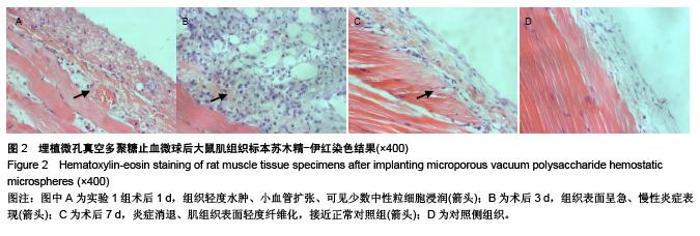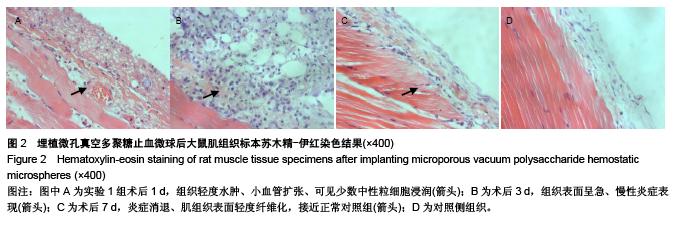Chinese Journal of Tissue Engineering Research ›› 2015, Vol. 19 ›› Issue (52): 8444-8449.doi: 10.3969/j.issn.2095-4344.2015.52.015
Previous Articles Next Articles
In vivo degradation and biological safety of microporous vacuum polysaccharide hemostatic microspheres
Du Bao-tang1, Shi Yue2, He Yuan-qing3, Yin Wen-jing3, Wang Ying2
- 1Jiangsu AOKE Biomedical Technology Co., Ltd., Zhenjiang 212003, Jiangsu Province, China; 2Department of Interventional Radiology, the 97th Hospital of Chinese PLA, Xuzhou 221004, Jiangsu Province, China; 3Centre of Experimental Animal, Jiangsu University, Zhenjiang 212002, Jiangsu Province, China
-
Received:2015-11-09Online:2015-12-17Published:2015-12-17 -
Contact:Shi Yue, Associate chief physician, Department of Interventional Radiology, the 97th Hospital of Chinese PLA, Xuzhou 221004, Jiangsu Province, China -
About author:Du Bao-tang, M.D., Professor, Jiangsu AOKE Biomedical Technology Co., Ltd., Zhenjiang 212003, Jiangsu Province, China -
Supported by:the Medical and Science Technology Innovation Plan of Nanjing Military Region, No. 2014ZD15
CLC Number:
Cite this article
Du Bao-tang, Shi Yue, He Yuan-qing, Yin Wen-jing, Wang Ying. In vivo degradation and biological safety of microporous vacuum polysaccharide hemostatic microspheres[J]. Chinese Journal of Tissue Engineering Research, 2015, 19(52): 8444-8449.
share this article
| [1] Sauai A, Moore FA,Moore EE, et al. Epidemiology of trauma deaths: A reassessment. J Trauma. 1995;38(2):185-193. [2] Champion HR, Bellamy RF, Roberts CP, et al. A profile of combat injury. J Trauma. 2003;54(5):S13-S19. [3] Stewart RM, Myers JG, Dent DL, et al. Seven humdred fifty-three consecutive deaths in a level 1 trauma center: The argument for injury prevention. J Trauma. 2003;54(1):66-71. [4] Kauvar DS, Lefering R, Wade CE. Impact of hemorrhage on trauma outcome: an overview of epidemiology, clinical presentations, and therapeutic considerations. J Trauma. 2006;60(6 suppl):S3-S11. [5] 李钒,田丰,刘长军,等.急救止血材料的研究进展[J].材料导报, 2013,27(3):70-73. [6] 史跃,杜宝堂,何远清,等.多微孔多聚糖止血粉应用于软组织创伤出血[J].中国组织工程研究,2014,18(3):406-411. [7] 李东红,高华,李鹏熙,等.几种止血材料对兔实质脏器创伤止血性能的比较[J].创伤外科杂志,2012,14(5):435-435. [8] Emilia M, Luca S, Francesca B, et al. Topical hemostatic agents in surgical practice. Transfus Apher Sci. 2011; 45(3): 305-311. [9] Kim IY, Eichel L, Edwards R, et al. Effects of commonly used hemostatic agents ofn the porcine collecting system. J Endourol. 2007;21(6):652-654. [10] 张少锋,洪加源.医用生物可吸收止血材料的研究现状与临床应用[J].中国组织工程研究,2012,16(21):3941-3944. [11] 熊绪琼,梅昕,马凤森.多糖类可吸收止血材料的研究进展[J].中华创伤杂志,2015,31(6):571-574. [12] 武岳,王冰,姚天明.新型创伤急救止血材料的研究进展[J].中国临床实用医学,2014,5(4):78-80. [13] 中华人民共和国科学技术部.关于善待实验动物的指导性意见. 2006-09-30. [14] Granville-Chapman J, Jacobs N, Midwinter MJ. Per-hospital haemostatic dressings: a systematic review. Injury. 2011; 42(5): 477-459. [15] Gruen RL, Brohi K, Schreiber M, et al. Haemorrhage control in severely injured patients. Lancet. 2012;380(9847): 1099-1108. [16] Seyedenejad H, Imani N, Jamieson T, et al. Topical haemostatic agents. British J Surg. 2008;95(10):1197-1225. [17] Schwartz M, Madariaga J, Hirose R, et al. Comparison of a new fibrin sealant with standard topical hemostatic agents. Arch Surg. 2004;139(11):1148-1154. [18] Spotnitz WD. Fibrin sealabt: past, present, and future: a brief review. World J Serg. 2010,34(4):632-634. [19] Jackson MR. Fibrin sealants in surgical practice: an overview. Am J Surg. 2001;182(2 suppl):1S-7S. [20] Palm MD, Altman JS. Topical hemostatic agents: a review. Dermatol Surg. 2008;34(4):431-445. [21] Achneck HE, Sileshi B, Jamiolkowski RM, et al. A comprehensive review of topical hemostatic agents efficacy and recommendations for use. Ann Surg. 2010;251(2): 217-228. [22] 余雪松,黄赤兵,张艮甫.局部止血材料临床应用现状[J].创伤外科杂志,2008,10(6):565-567. [23] Alam HB, Burris D, DaCorta JA, et al. Hemorrhage Control in the Battlefield: Role of New Hemostatic Agents. Mil Med. 2005;170(1):63-69. [24] 刘亚平,侯春林,顾其胜,等.可生物降解止血粉的制备及其止血性能[J].中国重建外科杂志,2007,21(8):829-832. [25] 杜宝堂.利用植物淀粉经交叉乳化制备术中止血材料的方法:中国,201110073208.2[P].2013-07-17. [26] 史跃,沈烈,杜宝堂,等.微孔多聚糖止血球组织吸收实验研究[J].医疗卫生装备,2014,35(8):15-18. [27] Tschan CA, Nie M, Schwandt E, et al. Safety and efficacy of microporous polysaccharide hemospheres in neurosurgery. Neurosurgery. 2011;69(1 suppl operative):49-62. [28] 牛雯,刘毅,刘曼玲.一种可吸收止血材料的生物降解研究[J].中国新药杂志,2012,19(4):336-339. [29] 王勇,陆伟.体内可吸收止血材料研究及临床应用[J].生物医学工程杂志,2009,2(4):922-925. [30] 张华.甲状腺手术应用泰绫150例探讨[J].中国医药导报, 2009, 6(19):207-209. [31] Azevedo C, Marques M, Bombana A. Cytotoxic effects of cyanoacrylates used as retrograde filling materials: An in vitroanalysis. Pesqui Odontol Bras. 2003;17(2):113-118. [32] Yi KI, Louis E, Robert E, et al. Effects of commonly used hemostatic agents on the porcine collecting system. J Endourol. 2007;21(6):652-654. [33] Johan B, Pentti T. Blood protein adsorption onto chitosan. Biomaterials. 2002;23(12):2561-2568. [34] Ishihara M. Photocrosslinkable chitosan as a dressing for wound occlusion and accelerator in healing process. Bomaterials. 2002;23(3):833-840. [35] Tsuyoshi S. Locak hemostatic effects of mirocrystalling partially deacetylated chitin hydrochloride. J Biomed Mater Res. 2000;49(2):225-232. |
| [1] | Chen Ziyang, Pu Rui, Deng Shuang, Yuan Lingyan. Regulatory effect of exosomes on exercise-mediated insulin resistance diseases [J]. Chinese Journal of Tissue Engineering Research, 2021, 25(25): 4089-4094. |
| [2] | Chen Yang, Huang Denggao, Gao Yuanhui, Wang Shunlan, Cao Hui, Zheng Linlin, He Haowei, Luo Siqin, Xiao Jingchuan, Zhang Yingai, Zhang Shufang. Low-intensity pulsed ultrasound promotes the proliferation and adhesion of human adipose-derived mesenchymal stem cells [J]. Chinese Journal of Tissue Engineering Research, 2021, 25(25): 3949-3955. |
| [3] | Yang Junhui, Luo Jinli, Yuan Xiaoping. Effects of human growth hormone on proliferation and osteogenic differentiation of human periodontal ligament stem cells [J]. Chinese Journal of Tissue Engineering Research, 2021, 25(25): 3956-3961. |
| [4] | Sun Jianwei, Yang Xinming, Zhang Ying. Effect of montelukast combined with bone marrow mesenchymal stem cell transplantation on spinal cord injury in rat models [J]. Chinese Journal of Tissue Engineering Research, 2021, 25(25): 3962-3969. |
| [5] | Gao Shan, Huang Dongjing, Hong Haiman, Jia Jingqiao, Meng Fei. Comparison on the curative effect of human placenta-derived mesenchymal stem cells and induced islet-like cells in gestational diabetes mellitus rats [J]. Chinese Journal of Tissue Engineering Research, 2021, 25(25): 3981-3987. |
| [6] | Hao Xiaona, Zhang Yingjie, Li Yuyun, Xu Tao. Bone marrow mesenchymal stem cells overexpressing prolyl oligopeptidase on the repair of liver fibrosis in rat models [J]. Chinese Journal of Tissue Engineering Research, 2021, 25(25): 3988-3993. |
| [7] | Liu Jianyou, Jia Zhongwei, Niu Jiawei, Cao Xinjie, Zhang Dong, Wei Jie. A new method for measuring the anteversion angle of the femoral neck by constructing the three-dimensional digital model of the femur [J]. Chinese Journal of Tissue Engineering Research, 2021, 25(24): 3779-3783. |
| [8] | Meng Lingjie, Qian Hui, Sheng Xiaolei, Lu Jianfeng, Huang Jianping, Qi Liangang, Liu Zongbao. Application of three-dimensional printing technology combined with bone cement in minimally invasive treatment of the collapsed Sanders III type of calcaneal fractures [J]. Chinese Journal of Tissue Engineering Research, 2021, 25(24): 3784-3789. |
| [9] | Qian Xuankun, Huang Hefei, Wu Chengcong, Liu Keting, Ou Hua, Zhang Jinpeng, Ren Jing, Wan Jianshan. Computer-assisted navigation combined with minimally invasive transforaminal lumbar interbody fusion for lumbar spondylolisthesis [J]. Chinese Journal of Tissue Engineering Research, 2021, 25(24): 3790-3795. |
| [10] | Hu Jing, Xiang Yang, Ye Chuan, Han Ziji. Three-dimensional printing assisted screw placement and freehand pedicle screw fixation in the treatment of thoracolumbar fractures: 1-year follow-up [J]. Chinese Journal of Tissue Engineering Research, 2021, 25(24): 3804-3809. |
| [11] | Shu Qihang, Liao Yijia, Xue Jingbo, Yan Yiguo, Wang Cheng. Three-dimensional finite element analysis of a new three-dimensional printed porous fusion cage for cervical vertebra [J]. Chinese Journal of Tissue Engineering Research, 2021, 25(24): 3810-3815. |
| [12] | Wang Yihan, Li Yang, Zhang Ling, Zhang Rui, Xu Ruida, Han Xiaofeng, Cheng Guangqi, Wang Weil. Application of three-dimensional visualization technology for digital orthopedics in the reduction and fixation of intertrochanteric fracture [J]. Chinese Journal of Tissue Engineering Research, 2021, 25(24): 3816-3820. |
| [13] | Sun Maji, Wang Qiuan, Zhang Xingchen, Guo Chong, Yuan Feng, Guo Kaijin. Development and biomechanical analysis of a new anterior cervical pedicle screw fixation system [J]. Chinese Journal of Tissue Engineering Research, 2021, 25(24): 3821-3825. |
| [14] | Lin Wang, Wang Yingying, Guo Weizhong, Yuan Cuihua, Xu Shenggui, Zhang Shenshen, Lin Chengshou. Adopting expanded lateral approach to enhance the mechanical stability and knee function for treating posterolateral column fracture of tibial plateau [J]. Chinese Journal of Tissue Engineering Research, 2021, 25(24): 3826-3827. |
| [15] | Zhu Yun, Chen Yu, Qiu Hao, Liu Dun, Jin Guorong, Chen Shimou, Weng Zheng. Finite element analysis for treatment of osteoporotic femoral fracture with far cortical locking screw [J]. Chinese Journal of Tissue Engineering Research, 2021, 25(24): 3832-3837. |
| Viewed | ||||||
|
Full text |
|
|||||
|
Abstract |
|
|||||







